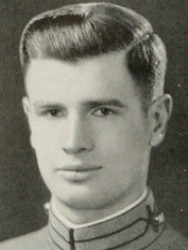Samuel Llewellyn Barbour Jr. was born on June 6, 1914, in New Mexico. He was the son of Samuel L. Barbour. He graduated from the U.S. Military Academy at West Point, Class of 1938. Initially aspiring to join the Air Force, he instead found his place in the Field Artillery. He was assigned to the 23rd Field Artillery (Philippine Scouts) at Fort Stotsenburg in the Philippines, serving as Executive Officer of Battery A. He was promoted to First Lieutenant in October 1940.
In February 1941, as the Philippine Scout Artillery expanded, Lieutenant Samuel L. Barbour was given command of Battery B, 23rd Field Artillery (Philippine Scouts), equipped with 2.94-inch mountain pack guns. He devised an innovative system for loading the guns onto trucks and established equipment standards later adopted by all port artillery units in the Philippines. Alongside his command duties, he also instructed officers in the operation of the 2.94-inch pack gun. Promoted to Captain in October 1941, Barbour was slated to become Executive Officer of the 86th Field Artillery Battalion, but the outbreak of war on December 8, 1941, halted the planned reorganization. When the Japanese attacked the Philippines on December 8, 1941, Cpt Barbourís Battery B, 23rd Field Artillery, was ordered into the field. In January 1942, his unit fought at Liack Junction, where it was nearly destroyed by enemy air, artillery, and infantry attacks. Despite being severely wounded in the leg by shrapnel, Barbour bravely drove a command car under heavy fire to rescue and evacuate wounded soldiers.
After recovery, he joined the 2nd Battalion, 24th Field Artillery (Philippine Scouts) and, in March 1942, volunteered to reconnoiter behind Japanese lines to contact guerrilla forces in the Zambales Mountains. Leading a small team, he navigated through enemy lines to Mount Pinatubo, successfully linking with guerrillas. Later, after the surrender of Bataan, he attempted to reach Corregidor, traveling by night through enemy territory. Crossing Manila Bay in a native canoe, he became the first American officer to witness and report the Bataan Death March. Upon arrival at Corregidor, he was promoted to Major and recommended for the Distinguished Service Cross.
Following the surrender of Corregidor, Major Samuel L. Barbour was first imprisoned in Manila, then transferred to Cabanatuan Prison Camp No. 1 in June 1942, where he commanded a company of American POWs until January 1943. Afterward, he volunteered for utility work, overseeing building maintenance and designing sanitation facilities that improved camp conditions. On October 12, 1944, he was moved back to Manila and later forced aboard a Japanese transport ship on December 13, 1944. The ship was bombed and sunk on December 15, but despite being severely wounded, Barbour survived. He was then placed on two more ships, one also bombed, before finally arriving at Moji, Japan, on January 31, 1945, and sent to Fukuoka Prison Camp No. 3. Though initially in relatively stable health, his weight had been reduced by half. In February 1945, he contracted beriberi and pneumonia and died on February 13, 1945, despite the efforts of American medical officers. He was cremated by the Japanese, with funeral services conducted by an American chaplain. His remains were later laid to rest at the Manila American Cemetery and Memorial in Manila, National Capital Region, Philippines.
Source of information: www.findagrave.com, alumni.westpointaog.org, weremember.abmc.gov

PRIVATE CITIZENS SUPPORTING AMERICA'S HERITAGE
American
War Memorials Overseas, Inc.
War Memorials Overseas, Inc.
Barbour Samuel Llewellyn, Jr.
Name:
Samuel Llewellyn, Jr. Barbour
Rank:
Major
Serial Number:
O-21218
Unit:
23rd Field Artillery Regiment
Date of Death:
1945-02-13
State:
New Jersey
Cemetery:
Manila American Cemetery and Memorial, Manila, Capital District, National Capital Region, Philippines
Plot:
D
Row:
2
Grave:
270
Decoration:
Purple Heart , Silver Star Medal with Oak Leaf Clusters, POW Medal
Comments:
